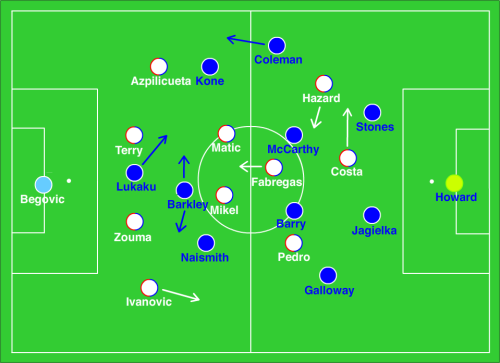For the first time in quite some time, Everton enter a league fixture against Chelsea above the London-based club. Chelsea have struggled so far this campaign, entering the match having conceded 10 goals in their first four fixtures.
Roberto Martinez’s side has started fairly well this season, having won against Southampton, drawing against Watford and Tottenham, and losing to Manchester City. While Everton looked bogged down when in possession at times last season, they have looked much more fluid. Martinez started his side in a 4-2-3-¼-2-2 with a diamond midfield, with Besic shuttling out wide from a central area. After Besic’s injury, Martinez’s side were very much a 4-2-3-1 with Naismith on the left.
As mentioned, Chelsea have had a poor start to the season with the lowest point being completely undone by their nearest title challengers in Manchester City. Mourinho had a quiet transfer window despite signs of decline from the likes of Ivanovic and Terry, two of his starters in the back four. For this match, the Chelsea boss started in a 4-2-3-1 with Matic and Mikel in the holding roles while Fabregas played behind Diego Costa.

Everton’s Fluidity
When Martinez’s teams are in good form, they play some of the best football in the league and this performance was a good display of that. Everton were so fluid with their ball movement when in possession and purposeful as they moved Chelsea’s centre midfield, crucially, from one side of the pitch to the other. In the build up for Naismith’s first goal, Everton completed 19 passes starting from the back after Jagielka won a good challenge against Diego Costa in the Everton penalty area. The movement of the ball looked to unsettle Mikel and Matic (more on this later), but Naismith’s lateral movement was key to a lot of Everton’s best play. The Scottish international would continually drift inside to try to overload the area that Matic and Mikel were covering, with Barkley and Lukaku also drifting in and out of it, allowing Everton to overload those central areas. On Naismith’s first goal, you can see after he passes out to Galloway, he is then unmarked during his run into the Chelsea penalty area.

As mentioned, Naismith’s movement in and around the left half space was essential to Everton overloading Chelsea in the central areas when the ball was on Everton’s right side. It allowed McCarthy and Barry to both take up supporting positions, which in turn, dragged Mikel and Matic out of the middle. Seamus Coleman’s width on the right was equally important; it gave Everton balance when Naismith drifted inside. Teams needs width to succeed and while overloading one area is important, it is equally important to have balance on the opposite side to not only catch the defense in unbalanced positions, but just as a pressure relief from. Everton have one of the best attacking right backs in the league so with Coleman providing width, it was always a danger for Chelsea and they were not allowed to ignore the threat. Below is a good example of Naismith’s central positioning and Coleman providing width and balance for the Everton attack on the right. This particular build up led to Kone’s chance that Begovic did well to save.

With Coleman going forward, it meant that there was usually a huge space behind him for Chelsea to exploit when they got on the ball and the same sort of space opened up for Chelsea with Naismith positioning himself so narrow. Diego Costa would constantly pull out wide into the same that Coleman left looking to get on the ball, while Ivanovic saw a lot of the ball on the right side of Chelsea’s attack. Costa was obviously a quick option and allowed Chelsea to get the ball forward into a 1v1 situation, although Costa never got the better of Stones. Ivanovic was an option typically when Chelsea were able to win the ball somewhere near the middle third and were able to play quickly before Everton dropped into their midblock.

Chelsea’s Centre Midfield
There have been problems with Chelsea’s centre midfield this season that were not as obvious last year. There is little depth in that area, especially with Oscar out injured. The problems here came with the double pivote of Mikel and Matic in Mourinho’s 4-2-3-1. It looked very clumsy and neither are particularly good at controlling a game’s tempo or acting as a deep-lying playmaker. With Fabregas and Matic in those roles, Fabregas is able to shoulder the responsible of breaking the lines and dictating the game’s tempo, though the Spaniard is a liability there as well. This was particularly true in the match against Manchester City when Fabregas’ tactical discipline was undone and allowed David Silva to control the match. Going forward, the issue for Chelsea during their build up was that Matic and Mikel struggling to get on the ball and if they did, they struggled to turn with it and play forward passes. Mikel did better than Matic in this respect, but the Nigerian never completed any forward passes that were significant.

As the match went on, and Everton’s defensive shape improved (more on that later), Fabregas began dropping deeper and deeper to get on the ball. At times Mikel, Matic, and Fabregas were all very deep and taking up the same spaces, which made it easy for Everton to defend and made Chelsea’s play rather predictable when Zouma or Terry were on the ball. Below is an excellent example of this. Notice Matic, Mikel, and Fabregas within about ten yards of one another. Also notice Naismith’s positioning; helping cut of passing lanes centrally, but allowing Ivanovic to get on the ball.

Without a central midfield that could dictate the tempo of the match, Chelsea looked incredibly sluggish in possession, causing them problems going forward. However, even with two defensive midfielders in the two holding roles, the defensive responsibilities and rotation of Mikel and Matic constantly allowed Everton to find space centrally. A lot of this had to do with Everton moving the ball well and the movement of Naismith and Barkley. The latter of which drifted from side to side through the middle of the pitch. The third goal, in particular, was an excellent example of Barkley’s play; he orchestrated the play on one side, drifted over when the ball was switched, got it, and then played Naismith in for his third goal. Both Matic and Mikel were constantly taken out of the centre midfield areas because of Barkley’s movement, but also because of Lukaku and Kone dropping into those areas and McCarthy and Barry in support. Naismith’s second goal showed this well. Lukaku dropped to the right, forcing Azpilicueta to pick him up and Kone moved outside, forcing Matic to track him wide. Mikel had to step to Lukaku after a 1-2 with Kone, which opened up the middle of the pitch for Barkley and Naismith. Below you can see the Chelsea midfield three highlighted and Naismith and Barkley in the foreground.

Everton’s Defensive Shape
For all their good play going forward, Everton also did well in their defensively responsibilities. As discussed above, Everton did well to force Fabregas back ti get on the ball, although this was partially due to Mikel and Matic being unable to really dictate Chelsea’s play well enough. However, most of the credit has to be given to how Everton defend. When the home side were defending, they looked very much like a 4-5-1, with the midfield flat and they defended very narrow, which allowed Ivanovic plenty of opportunities on the ball, as discussed. However, the best part of Everton’s compactness was that they eliminated the space between the lines that Fabregas, Pedro, and Hazard were always looking to get the ball in. Pedro and Hazard were constantly coming inside and Pedro, in particular, had some good spells were he strung a few passes together as he moved laterally across the midfield. Overall, however, Chelsea struggled to get those three players in dangerous spaces between Everton’s lines. Below is a good example of Everton’s compactness and Chelsea’s narrowness, except for Ivanovic on the right.

Chelsea never really managed to get a good opportunity in the Everton penalty area except for set pieces. In fact, Chelsea had just two shots on goal in the match, one being Matic’s goal when Everton were defending too deep considering the position of the ball. The other was a tame header from Falcao after Mourinho brought the Colombian on and switched to a 4-4-2.
Conclusion
An excellent result for Everton. They were fluid in possession and their forward passing and combinations were exceptional, starting from the back with the composure of John Stones on the ball. Naismith’s excellent scoring record against Chelsea continues, while Barkley and Stones showed their excellence.
For Chelsea, the pressure is building and building. This was a match that Mourinho would have expected to win, despite some open matches between the two sides in the past. The static duo of Matic and Mikel in midfield killed Chelsea going forward and both were repeatedly dragged out of position when Everton were able to combine going forward. As a result, Chelsea have now conceded 13 goals in their opening five fixtures and have lost three.
Peter Motzenbecker
Latest posts by Peter Motzenbecker (see all)
- Liverpool vs Manchester City: Tactical Analysis - January 17, 2018
- The Manchester Derby: Post-Match Tactical Analysis - September 13, 2016
- Arsenal vs Liverpool: The Tactical View - August 17, 2016
